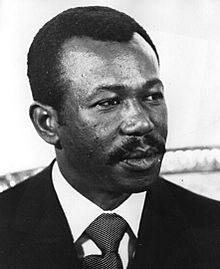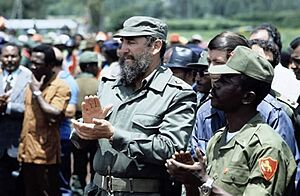Mengistu Haile Mariam facts for kids
Quick facts for kids
Mengistu Haile Mariam
|
|
|---|---|
|
መንግሥቱ ኀይለ ማርያም
|
|

Mengistu around 1978–79
|
|
| General Secretary of the Workers' Party of Ethiopia | |
| In office 12 September 1984 – 21 May 1991 |
|
| Preceded by | Position established |
| Succeeded by | Position abolished |
| President of Ethiopia | |
| In office 10 September 1987 – 21 May 1991 |
|
| Prime Minister | Fikre Selassie Wogderess Hailu Yimenu Tesfaye Dinka |
| Vice President | Fisseha Desta (1987–1991) Tesfaye Gebre Kidan (1991) |
| Preceded by | Himself as Chairman of the Derg |
| Succeeded by | Tesfaye Gebre Kidan (acting) |
| Chairman of the Derg and head of state of Ethiopia | |
| In office 17 November 1974 – 28 November 1974 Acting |
|
| Preceded by | Aman Mikael Andom |
| Succeeded by | Tafari Benti |
| In office 3 February 1977 – 10 September 1987 |
|
| Deputy | Atnafu Abate |
| Preceded by | Tafari Benti |
| Succeeded by | Himself as President |
| Personal details | |
| Born | 21 May 1937 Caffa & Ghimirra, Galla-Sidamo Governorate, Italian East Africa (now Ethiopia) |
| Political party | Workers' Party of Ethiopia (1984–1991) COPWE (1974–1984) |
| Spouse | Wubanchi Bishaw |
| Children | 3 |
| Military service | |
| Allegiance | |
| Branch/service | Ethiopian Army |
| Rank | Lieutenant Colonel Commander-in-Chief |
| Battles/wars | Ethiopian Civil War Eritrean War of Independence Ogaden War |
Mengistu Haile Mariam (born 21 May 1937) is a former Ethiopian politician and army officer who was the leader of Ethiopia from 1977 to 1991. He led a military group called the Derg that took control of the country. Mengistu served as the chairman of the Derg and later became the first president of the People's Democratic Republic of Ethiopia (PDRE).
The Derg came to power after the Ethiopian Revolution in 1974, which removed Emperor Haile Selassie. This ended the Solomonic dynasty, a line of rulers that had been in power since the 1200s. Mengistu became the country's dictator and tried to modernize Ethiopia's old economic system using ideas inspired by Marxism–Leninism. This meant the government took control of land and businesses.
His time in power was marked by a violent period known as the Ethiopian Red Terror from 1977 to 1978. This was a harsh campaign against groups that opposed the Derg. During his rule, Ethiopia also faced a war with Somalia and a major famine from 1983 to 1985, which brought international attention to the country.
In May 1991, Mengistu fled to Zimbabwe as opposition forces closed in on the capital city. This brought an end to the Ethiopian Civil War. An Ethiopian court later found him responsible for the deaths of thousands of people. Mengistu still lives in Zimbabwe today.
Contents
Early Life and Army Career
Mengistu Haile Mariam was born on May 21, 1937. After Italy's occupation of Ethiopia ended, his father joined the army. Mengistu grew up around army camps and later joined the military at a young age.
He was a good soldier and caught the attention of General Aman Andom, who helped him in his career. Mengistu attended the Holetta Military Academy, one of Ethiopia's top military schools, and graduated in 1957. He was later sent to the United States for military training, where he learned to speak English fluently.
Some people made negative comments about his appearance because of his family's background. This may have made him feel like an outsider. When he later gained power, he spoke out against the way some families looked down on people with darker skin.
The Rise of the Derg
In 1974, Emperor Haile Selassie's government was overthrown. A committee of soldiers called the Derg took control. Mengistu was a member of this committee. He was very skilled at politics and quickly rose to become a leader of the group.
The Derg, under Mengistu's leadership, ordered the removal of many officials from the old government. Mengistu has said that the Derg made these decisions as a group, but other members have said he was in full agreement.
Leadership of Ethiopia
Mengistu became the official leader of the Derg in 1977 after a shootout where the previous chairman, Tafari Benti, was killed. Mengistu then removed his main rival, Atnafu Abate, which gave him complete control of the country.
Political Conflicts

Many groups opposed the Derg's rule. The main opposition was the Ethiopian People's Revolutionary Party (EPRP). Mengistu's government cracked down hard on the EPRP and other opponents in a period that became known as the "Red Terror."
In a public speech in 1977, Mengistu declared "Death to counterrevolutionaries!" He smashed three bottles of red liquid on the ground to show what would happen to his enemies. In the months that followed, thousands of young people were killed in the capital city, Addis Ababa, and other towns.
While this was happening, Ethiopia was also fighting a war against Somalia and dealing with rebels in the regions of Eritrea and Tigray. With help from the Soviet Union and Cuba, Ethiopia won the war against Somalia. By the late 1970s, Ethiopia had one of the largest armies in Africa.
Adopting a New System
Mengistu wanted to change Ethiopia's economy based on Marxism–Leninism. This is a system where the government controls most of the country's resources. The government took over all rural land, which had belonged to the church, the royal family, and wealthy nobles.
The government also took control of all major companies, banks, and businesses. Farmers were forced to work on large, government-run farms called collective farms. However, these changes, along with war and drought, led to food shortages. A terrible famine in 1984 caused many deaths and drew worldwide attention.
In 1987, a new constitution was created, and the country was renamed the People's Democratic Republic of Ethiopia. Mengistu became president, giving him almost total power.
End of His Rule
By the late 1980s, Mengistu's government grew weaker. The army suffered major defeats against rebel groups. In 1989, while Mengistu was visiting East Germany, some senior army officers tried to overthrow him in a coup. The attempt failed, but it showed that his support was fading.
By 1990, the Soviet Union, which had been his main supporter, was collapsing and stopped its aid to Ethiopia. In May 1991, rebel forces surrounded the capital city. Mengistu fled the country and was given a safe place to live in Zimbabwe by its president, Robert Mugabe.
His government fell just a week later. The new government arrested most of the Derg officials who were left behind.
Life in Zimbabwe
Mengistu has lived in Zimbabwe since 1991. In 1995, a man tried to attack him while he was on a walk, but Mengistu was not hurt. The attacker was arrested and sent to prison.
As of 2018, Mengistu was still living in Zimbabwe. The Ethiopian government has asked for him to be sent back to Ethiopia, but Zimbabwe has refused.
Court Trial
The new Ethiopian government put Mengistu on trial for the deaths of thousands of people during his rule. Because he was living in Zimbabwe, he was tried in absentia, which means he was not present in the courtroom.
The trial started in 1994 and ended in 2006. The court found Mengistu guilty and sentenced him to life in prison. Later, in 2008, a higher court changed the sentence to the death penalty. Many of his top officials were also found guilty.
Human rights groups estimate that hundreds of thousands of people were killed during the Red Terror.
Personal Life
Mengistu married Wubanchi Bishaw in 1968. They have one son, Andinet, and two daughters, Tigist and Timihirt. In 2010, Mengistu announced he was writing his life story. A version of his book, called Tiglatchin (which means "Our Struggle"), was later published.
Images for kids
See also
 In Spanish: Mengistu Haile Mariam para niños
In Spanish: Mengistu Haile Mariam para niños




